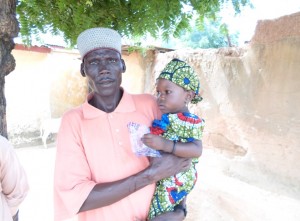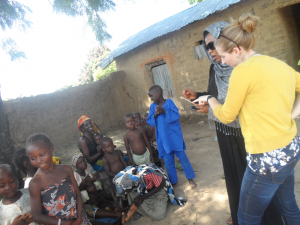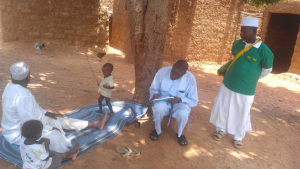In small northern Nigerian villages such as Bukka, 56 miles southeast of Kano City, health workers walk dusty paths under the searing heat of the tropical afternoon carrying lifesaving malaria drugs to children. Often, they work past sunset to ensure that they administer the drugs to as many eligible children as possible in a day. Abubakar Iliyasu, one such worker who began during the distribution program’s early stages, has seen it progress and overcome early challenges. “In some places parents even hid their children,” he said. “When I get one person that brought out his child and I gave him the drug on the first round, when they see its effect they then brought their children on the second round, they come out in mass. The turnout was even too much on the second round.”
A Community Directed Distributor prepares to give SPAQ to eligible children in a household
According to the 2014 UNICEF World Renewed Report, nearly one in five children’s deaths in Nigeria is caused by malaria, resulting in about 170,000 under-5 deaths per year. Children in Kano State, the most populous state in Nigeria where Bukka and other villages like it are located, are particularly hard-hit. The area is home to the highest number of child deaths in Nigeria. The under-5 mortality rate is 217 per 1,000, nearly double the national figure. Of these deaths, over a quarter are directly attributable to malaria, representing approximately 16 percent of the country’s malaria burden. Apart from Kano City, the state’s capital which is largely urban and a huge trading hub for northern Nigeria, the rest of the state is characterized by its largely agrarian economy and health statistics that lag behind much of the country.
Northern Nigeria is part of the Sahelian Belt, which stretches across sub-Saharan Africa and also includes parts of Senegal, Mauritania, Mali, Burkina Faso, Algeria, Niger, Chad, and Eritrea. These areas have markedly high seasonal malaria incidence. Approximately 60 percent of annual rainfall occurs within just 3-4 consecutive months and is accompanied by a concurrent peak in malaria incidence. Malaria remains a leading killer of children under 5 years old not only in Nigeria, but also in many countries around the world. In 2015 alone, nearly 600,000 people will die of malaria, a preventable and treatable disease, and almost 200 million will become sick.
Seasonal Malaria Chemoprevention (SMC) is a proven, World Health Organization-recommended intervention that provides children with antimalarial drugs, specifically sulfadoxine-pyrimethamine and amodiaquine (SPAQ) during the rainy season to prevent them from becoming sick with malaria. SMC is recommended for northern Nigeria and other areas in that lie within the Sahelian Belt to combat the devastating impact of seasonal malaria there. While SMC has been shown to reduce malaria cases and deaths by as much as 75 percent, increasing access to all eligible children remains an enormous logistical challenge. Since SPAQ protects children for about a month, SMC involves getting the drug to children each of the four months of the rainy season, and it must be conducted year after year for as long as children remain at risk of infection.
In order to help prevent children in Nigeria from contracting malaria, in 2013 and 2014, CHAI supported the Kano State Malaria Elimination Program during the rainy seasons, which take place between either August to November or July to October, to train community health volunteers called Community Directed Distributors (CDDs)—Abubakar Iliyasu is a CDD is Bukka—to distribute antimalarials to over 60,000 children. Administration of the first dose is supervised by the CDD; caregivers give children the remaining two doses over the next two days following instructions handed down by the CDDs to complete a three-day course for any given month.
Town crier Mohammed Ni’ima, who also lives in Bukka village with his family, is a parent who not only allowed CDDs to provide SMC to his 3-year old daughter Umma, but also served as a key figure for community mobilization. Mohammed initially learned about SPAQ during the community sensitization meetings held in his ward prior to the start of the drug administration in June 2013. He then became actively engaged in promoting the program through his work as town crier, making public announcements in the streets and marketplace of Bukka.
“I am happy to be part of this project, helping through my work to create awareness about malaria prevention for children under 5 years using these tablets,” he said. “My daughter has taken her second course of drugs and she is very healthy, with no malaria.”
 Mohammed Ni’ima and his daughter Umma
Mohammed Ni’ima and his daughter Umma
Given the challenges of delivering SMC month after month and year after year to ensure that children are adequately protected, CHAI has been working to help the Kano State Malaria Elimination Program find the most cost-effective ways of administering SPAQ. In 2013, a pilot project funded by Malaria No More UK and the UK Department for International Development examined the costs and coverage achieved by delivering SMC door-to-door, at a single distribution point within the village, or by selling the drugs for a low price through private sector shops. The pilot demonstrated that having CDDs deliver drugs door-to-door was more expensive than the other approaches, but that these higher costs were outweighed by the much higher fraction of children who successfully received drugs. In total, it was estimated that approximately 22,000 child illnesses and 200 deaths were prevented by the 2013 drug distribution.
 CHAI staff inspecting a child’s treatment card during a spot check visit to a participating SMC household
CHAI staff inspecting a child’s treatment card during a spot check visit to a participating SMC household
Kano State and CHAI continued to work to maximize the impact of SMC in 2014. In this region, high rates of malnutrition likely exacerbate the negative health consequences of malaria, so much so that it has been estimated that 50 percent of malaria deaths may be attributable to malnutrition. Therefore, CHAI and the Kano State Malaria Elimination Program sought to examine whether both malaria mortality and nutritional outcomes could be improved if SMC drugs were bundled with a lipid-based nutritional supplement (LNS). Supported by funding from the Children’s Investment Foundation Fund and a donation of LNS from Nutriset, CHAI partnered with the Kano State Malaria Elimination Program to roll out an integrated distribution of both SMC and nutritional supplement to a target population of 10,000 under-5 children.
Comparison of the children receiving the integrated distribution with those receiving only the SMC drugs suggested that children receiving both SMC and the nutritional supplement were even more protected against malaria than those receiving SPAQ alone. Overall, the project was estimated to have averted approximately 7,000 child illnesses and up to 70 deaths. It also provides intriguing evidence for how future SMC campaigns can be improved to save even more lives across the Sahelian Belt.
Given the success of adding nutritional supplements to SMC, CHAI is exploring other commodities or services that can be bundled with the campaign. CHAI is currently investigating opportunities to scale up the SMC campaign to all of Kano State, with the goal of reaching approximately 2.5 million children under 5. As town crier Mohammed Ni’ima said, his daughter Umma is “living testimony of the benefit of administering SPAQ. I wish it had been available in past years. My daughter has not had malaria since she started taking this drug.” In an effort to ensure Umma and countless other children are able to access SMC, he Kano State Malaria Elimination Program and CHAI are working closely with the new Kano State leadership to secure resources for the 2016 rainy season.






